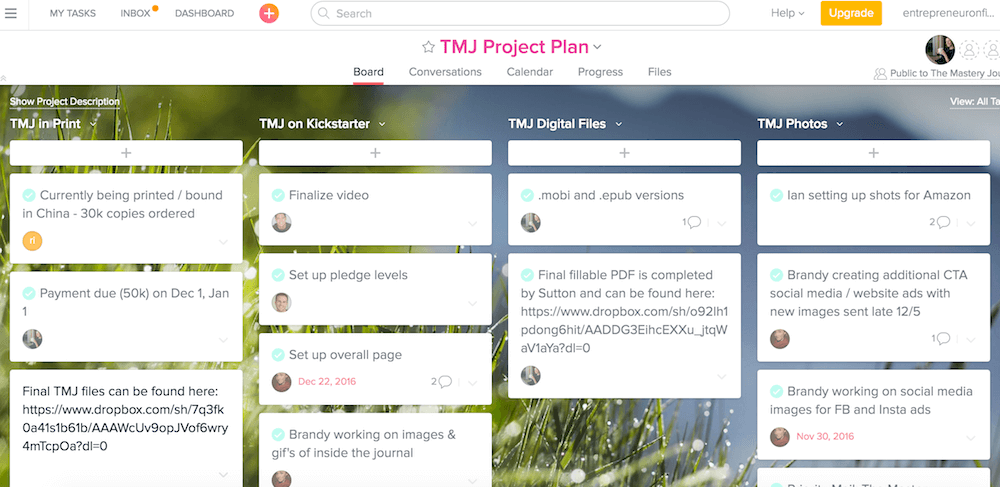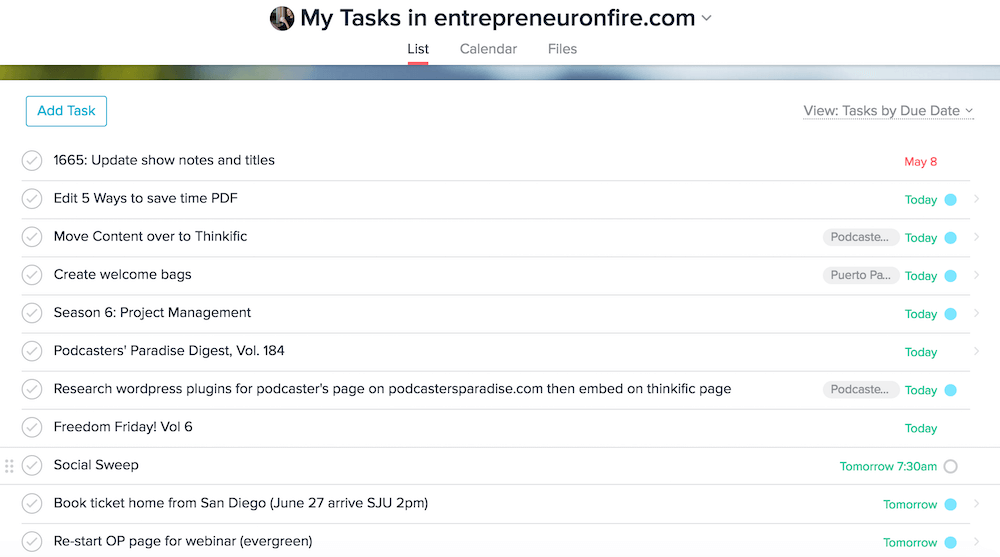
So now you know what project management is, why it’s important, how to get started and what some of the top tools for helping you manage your projects most efficiently are.
Managing new and existing projects at the same time
Next comes actually managing your projects!
In the first two episodes of Season 6 we laid the groundwork; now it’s time to roll up your sleeves and get your hands dirty.
Bringing on new projects
But before we dive straight into how to manage new and existing projects at the same time, I want to make sure you feel confident about how to determine whether or not an idea you have is something that should even turn into a project in the first place.
If we’re going to talk about new and existing projects, let’s first make sure you’re making smart choices when it comes to what makes it on to ‘project status’ in your business.
This is a really important step in the process, because until you can start saying no to some of the things in your business that are likely things you should NOT be spending your time on, it’s going to be difficult to effectively manage the things you SHOULD be spending time on.
Let’s say you’ve come up with a new idea – something you’ve been toying with trying out because you think it might help you:
- Grow your email list;
- Create a better user experience on your site;
- Increase ROI with your Facebook ads…
…or any other number of things.
Before your idea turns into a project, I urge you to STOP and evaluate.
Step 1: STOP
Seriously, just stop.
You’re probably fired up about your idea, and maybe with good reason! The outcomes I’ve listed above are pretty sweet. BUT, to ensure you’re spending your time wisely, you need to evaluate whether or not turning your idea into an actual project is reasonable.
Step 2: Evaluate
So how do you know?
Turning your idea into an actual project has to pass these 3 checks:
- Your overall business goals,
- Your current available bandwidth, and
- The priority you’re willing to give your idea.
The first check is simple: if you turn your idea into a project, will it help you get one step closer to accomplishing your overall business goals? If yes, then let’s put it the test with the second check: bandwidth.
For some reason we love to over-book ourselves.
Let’s say “YES!!” to everything, even though we know we don’t have the time to do it!
Sound familiar?
If yes, the next book you should read is Essentialism by Greg McKeown.
Be honest with yourself: do you have the bandwidth to take on another project right now?
And finally, you have to be able to determine the priority you’re willing to give this new idea. Based on the other projects you’re already managing and the other responsibilities you have in your business (and your personal life), is this idea something you’re willing to give priority to?
Managing your new projects with your existing projects
Let’s say your idea passed all the checks, and you’re ready to bring it on board as an actual project.
Awesome!
Now it’s time to make sure that you’re managing all of your projects – both new and existing – most efficiently so that your new projects don’t take over your existing ones, and so that your existing ones don’t totally shut out your new ones.
Enter: a white board and Asana.
I use my white board to keep myself in check with the projects I’m currently managing, because let’s be real: sometimes we like to stretch the truth with ourselves, or we might simply “forget” about the big honking project we’ve already committed to.
With a whiteboard in place you can easily track and manage the status of your different projects visually with three columns:
- To do
- Doing
- Done
So maybe one of your ideas didn’t pass the checks this time – toss it up under the “To do” section!
If it passed the test, but you’re not quite ready to dive in just yet – another “To do”.
Maybe you’re diving in TODAY, in which case you definitely want to account for it under your “Doing” section.
And done? Score! Congrats :) It’s always a pretty awesome feeling to be able to SEE the progress you’re making.
White board: Check.
Now that you can clearly see every project that’s going on (or about to go on) in your business, it’s time to bust out those project management skills and get those bad boys broken down into individual steps and deliverable with the help of Asana.
Here is the project plan I put together in Asana for The Mastery Journal launch:

I first made a list of the overall categories for deliverables I knew we needed to hit, like having The Mastery Journal printed, getting the page published in Kickstarter, creating the digital files, having images that we could share, and so on.
Then, within each of those categories for deliverables are the specific steps necessary to hit that deliverable.
For example, in order to have our Kickstarter page published, we needed a video (that smiling face belongs to Brandon T. Adams), pledge levels (put together by our very own JLD), creating the overall page layout (that’s our design pro Brandy Shea), etc.
By moving my project into Asana I’ve given myself a dashboard where I can sort and organize specific tasks and due dates, attach files and reference materials, and assign individual things to team members involved.
If you’re in charge of managing a project – whether it’s on your own or with a team – some type of project management tool is absolutely necessary for ensuring your project is managed properly.
Why I recommend Asana so much is that it not only offers you the tools to be able to put a project plan together, it also helps remind you of important due dates and holds you accountable for doing what you said you were going to do (same goes for your team members).
Plus, with access to your own profile dashboard, you can see what it is you have coming due at a single glance (my favorite sort is by ‘due date’ so you know what tasks have priority over others):

If you’re not currently tracking your projects using something like Asana, it’s going to take some time to populate the information, but let me assure you once you’ve done this, your ability to manage your projects will have skyrocketed.
Don’t be overwhelmed or discouraged by this move, either. Just take it one project at a time, one step at a time.
Once you have your project plans populated, you’ll be managing new and existing projects at the same time without missing a beat!
Next up in Season 6
Next up we’ll be talking about what to do when something goes wrong with your project.
